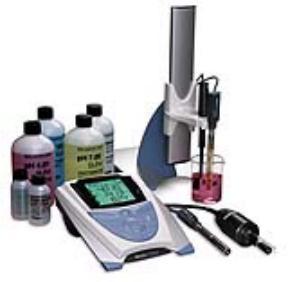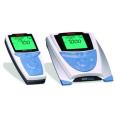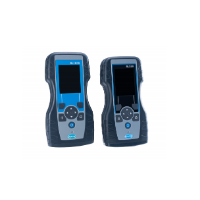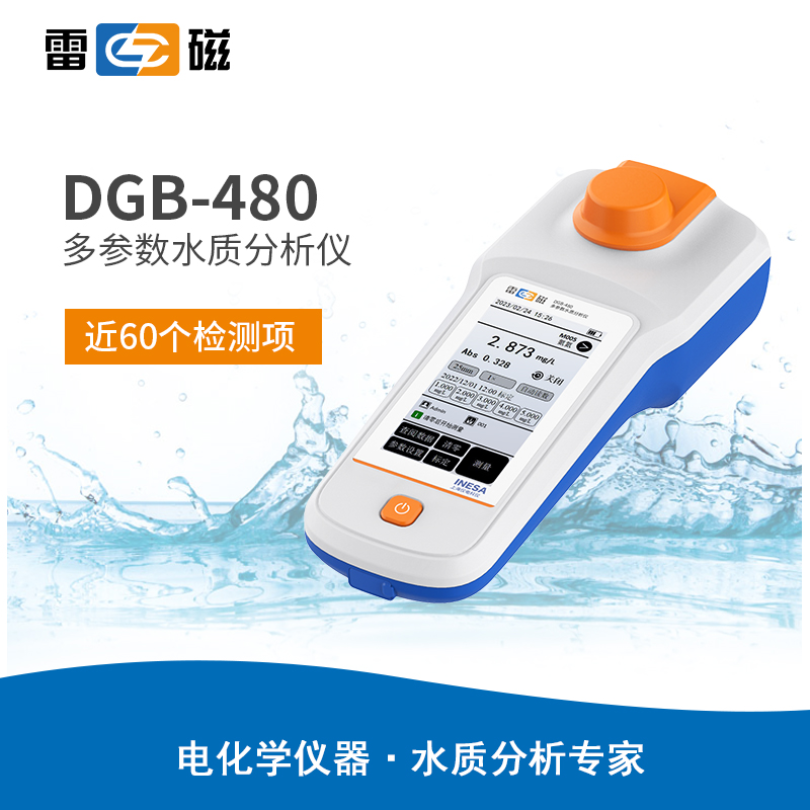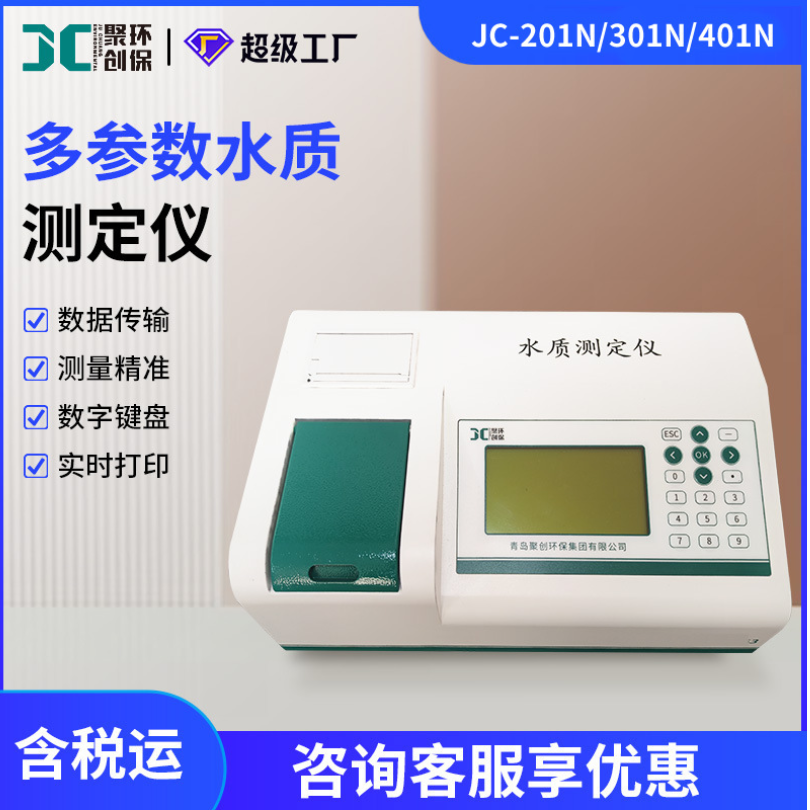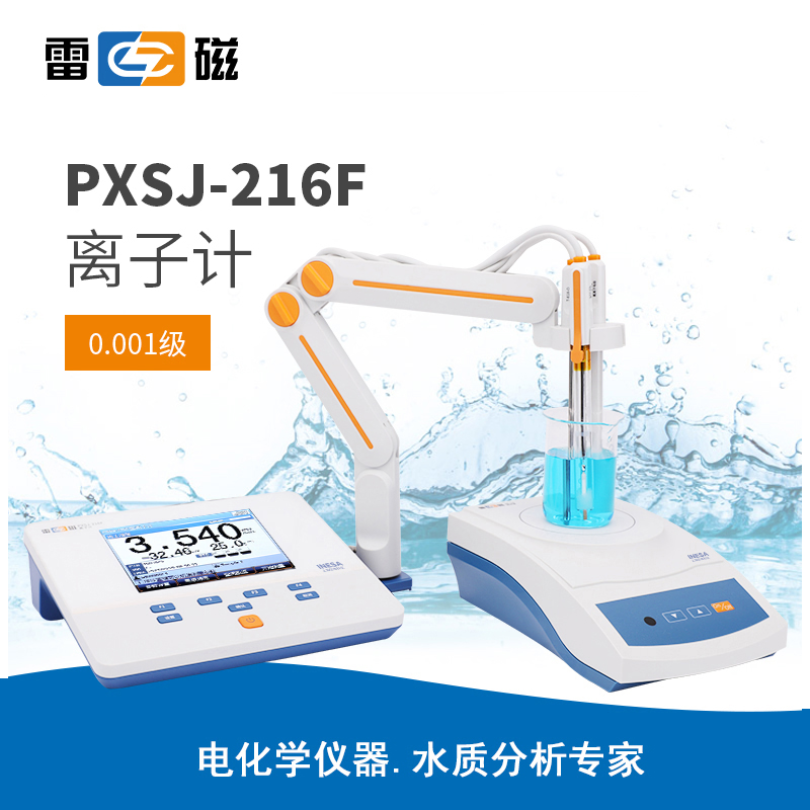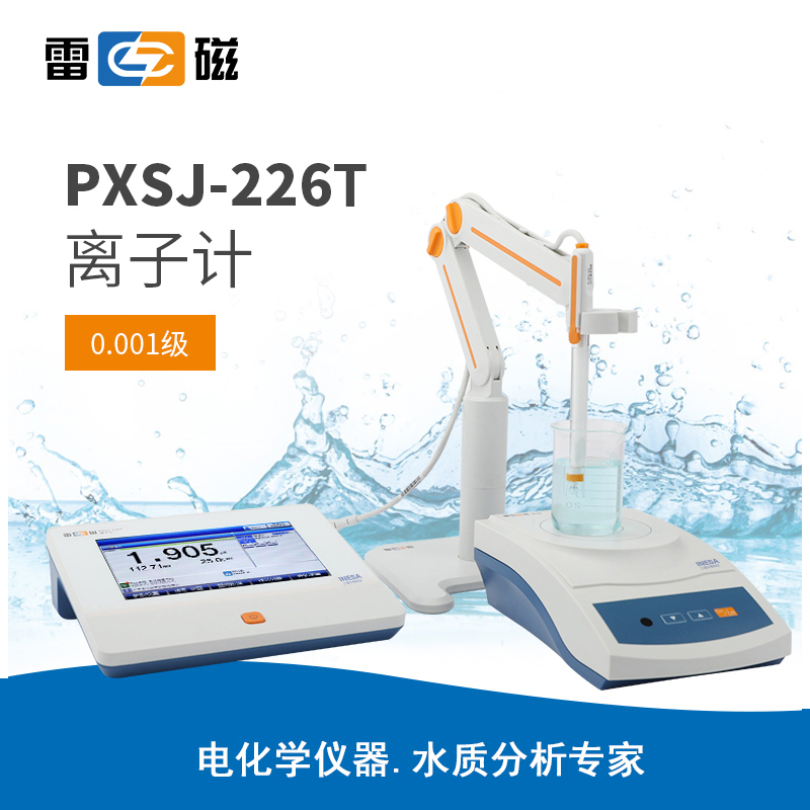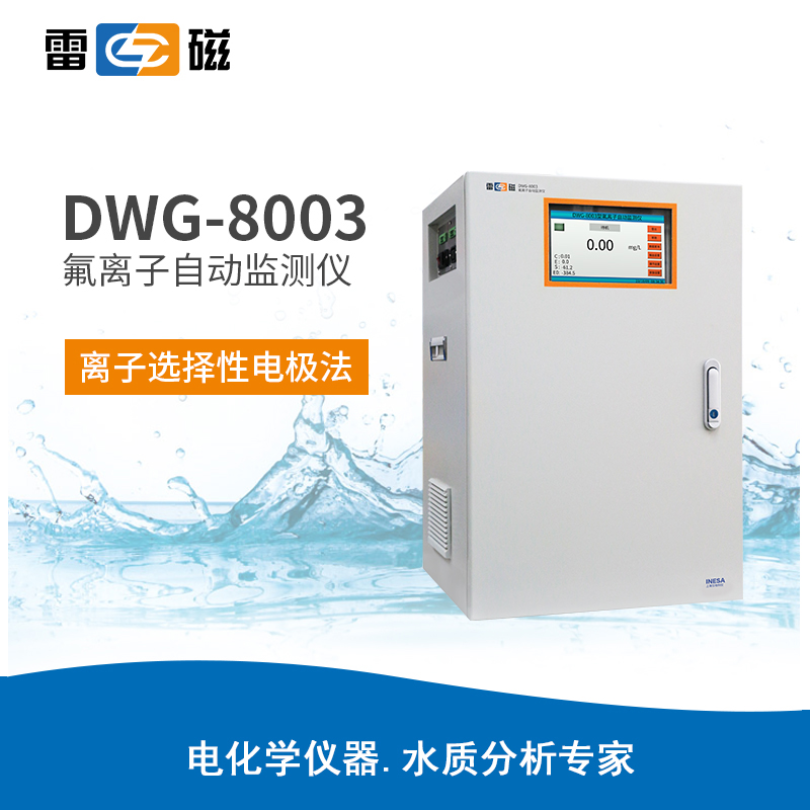本文章详细介绍了防腐剂中碘的测定,包括校准液、水样的准备,校准和测量过程,以及电极和仪表的维护等内容
方案详情

Iodine inOTC AntisepticsIodine inOTC Antiseptics Iodine inOTC Antiseptics Calibration and Analysis 1 Allow all the standards and the samples to attain room temperature for precise measurements, sincethe measurement is temperature sensitive. 2.Calibrate the meter using the 0.127 % followed by the 1.27 % standard, stirring the standards at agentle and uniform rate. 3.Place the electrode and stirrer into the beaker with the 0.127 % standard such that the electrode tip isfully immersed in the solution. The stirrer should be positioned slightly below the tip of the electrode.Press the STIRRER key on the meter to turn the stirrer on. Press the CALIBRATE key. 4.Wait for a stable reading (1-2 minutes). Enter the standard value of"0.127 “ using the UP andDOWN arrow keys and the DECIMAL/DIGIT key. 5. Press the CALIBRATE key to accept the 0.127 % standard and press the STIRRER key to turn thestirrer off. 6.Rinse electrode and stirrer thoroughly with deionized water. Gently remove excess solution from theouter sleeve of the electrode by dabbing with a clean paper tissue. Do not wipe or rub the sensingelement of the electrode. 7.1Place the probe and stirrer into the beaker with the 1.27 % standard such that the electrode tip isfully immersed in the solution. The stirrer should be positioned slightly below the tip of the electrode.Press the STIRRER key on the meter to turn the stirrer on. 8.Wait for a stable reading (1-2 minutes). Enter the standard value of"1.27”using the UP and DOWNarrow keys and the DECIMAL/DIGIT key. 9. P1ress the MEASURE key to accept the 1.27 % standard and to move to the measure mode of themeter. Press the STIRRER key to turn the stirrer off. 10. Rinse the electrode and stirrer thoroughly with deionized water. Gently remove excess solution fromthe outer sleeve of the electrode by dabbing with a clean paper tissue. Do not wipe or rub the sensingelement of the electrode. 11. Place the probe and stirrer in the prepared sample with the electrode tip fully immersed in thesolution. Press the MEASURE key on the meter; the stirrer will turn on. The ISE: % icon will flash asthe measurement is being made. The ISE: % icon will become solid and the display value will freezewhen a stable reading is achieved. This value is logged and printed automatically and the stirrer turnsoff automatically. 12. Repeat steps 10 and 11 for additional samples. Upon completion of samples, rinse electrode withdeionized water and store the electrode according to instructions in the Electrode Storage section ofthis method note. Introduction This method provides rapid, uncomplicated determinations of the Total elemental Iodine in two simplesteps. First, Iodine is reduced to Iodide by the addition of Sodium Thiosulfate. Then, the Iodide ion ismeasured directly with ISE electrode. The direct measurement of ions using ion selective electrodes is awell-established technique frequently used as a standard method of analysis, as a quality control step and tofulfill labeling requirements. This procedure eliminates interferences associated with the presence of colorand solids. Recommended Equipment Cat. No. ISE application package (Includes all Items with a catalog number) 1010164 1. 4 Star benchtop pH/ISE meter 1115000 2.iionplus" Iodide electrode 9653BNWP 3. Orion stirrer (or magnetic stir plate and bar) 096019 4. Orion benchtop electrode stand 1110001 5. Volumetric flask (100 mL) 6. Beakers (150 mL) 7. Graduated cylinder (100 mL) 8. Pipette (2mL, 10 mL, 25 mL, 50 mL) Required Solutions Cat.No. 1. 0.1 M Iodide Standard Solution 945306 2. Reference Filling Solution, Optimum Results"D 900063 3. Ionic Strength Adjustor (ISA) 940011 4. Sodium Thiosulfate,0.1 M 5. Deionized water Calibration Standard Preparation 1. Using a graduated cylinder, transfer 100 mL of the 0.1 M standard into a beaker. Add 2 mL ISA. This0.1 M standard will be used as 1.27% in calibration. 2.To prepare a 0.01 M Iodide standard, pipette 10 mL of the 0.1M Iodide standard and 2 mL of theIodide ISA solution into a 100 mL volumetric flask. Dilute to the mark with the deionized water. Mixwell. This 0.01 M standard will be used as 0.127% in calibration. Sample Preparation 1. Pipette 25 mL of sample, 25 mL of deionized water, 50 mL of sodium thiosulfate, and 2 mL ISA intothe 150 mL beaker. Mix well. 2. Repeat this procedure for additional measurements. Results Five aliquots of Povidone-Iodine solution were prepared as described above and measured for Iodide. The resultson the meter are displayed as % w/v of Iodine. The concentration of the Iodine in the undiluted sample iscalculated by multiplying the result by 4 (dilution factor). Bellow are the results of the analysis: Povidone-Iodine % Iodine Sample #1: 2.02 Sample #2: 2.02 Sample #3: 2.04 Sample #4: 2.10 Sample #5: 2.06 Mean: 2.05 Standard Deviation: 0.03 %CV 1.63 Electrode Storage The filling solution in the Iodide electrode should not be allowed to evaporate, which causes crystallization. For brief storage periods between sample measurements, store the electrode in deionized water. For storage longer than one week, drain the electrode, flush the Inside with deionized water and store dry withthe cap on to protect the sensing element. Set Up Electrode Setup 1. Fill the outer chamber with Optimum Results D filling solution. 2.Lift the filling solution bottle's spout to a vertical position. 3.Insert the spout into the filling hole in the outer sleeve of the electrode and add a small amount of fillingsolution to the chamber. Then tip the electrode to moisten the o-ring at the top and return electrode to avertical position. 4. Holding the electrode by the barrel with one hand, use the thumb to push down on the electrode cap,allowing a few drops of filling solution to drain wetting the inner cone. For initial meter setup follow the steps on the Reference Panel which is attached to the meter itself. The QuickStart Guide also contains a layout of the meter keypad for reference. The words in this method In all capitalssuch as POWER indicate a key on the meter, and words in quotations such as “Unitindicate Information onthe meter display. 1. Connect the electrode to the meter. ..Connect the stirrer to the meter. 3P.ress the POWER key on the meter to turn the meter on. 4.Note that the arrow on the left of the screen indicates the active line. If the top line is not active, press theLINE SELECTION key to change the selected line to the top line. Then press the UP or DOWN arrowkeys to change the measurement mode of the top line to ISE. .Press the SETUP key to enter ISE Setup. Press the LINE SELECTION key to select the bottom line. Pressthe UP or DOWN arrow keys to select“3”for “rES”which is an abbreviation for resolution or number ofsignificant digits. Press the LINE SELECTION key to accept setting. 6.Press the LINE SELECTION key to select the middle line, and press the DOWN arrow key to select“nLln”which is an abbreviation for non-linear blank correction. 7.P.ress the LINE SELECTION key to select the bottom line. Press the UP or DOWN arrow keys to select“off"for“nLln”. Press the LINE SELECTION key to accept setting. 8.Press the LINE SELECTION key to select middle line, and press the DOWN arrow key to select “rAng"which is an abbreviation for measurement range. 9.Press the LINE SELECTION key to select the bottom line. Press the UP or DOWN arrow keys to select“HigH” for “rAng”. Press the LINE SELECTION key to accept setting. 10. Press the LINE SELECTION key to select middle line, and press the DOWN arrow key to select“Unit". 11. Press the LINE SELECTION key to select the bottom line. Press the UP or DOWN arrow keys to select“PEr”(%) for“Unit. Press the LINE SELECTION key to accept setting. 12. Press the MEASURE key to return to the measurement mode. If all steps were followed correctly the meter display will show three digits in the top line and “ISE: PEr “ to theright of the top line. The meter and electrode are now ready for calibration. Note: The Orion Benchtop Stirrer must be turned on in General Instrument Setup before analysis, please see the Quick StartGuide for instructions. ofof
确定
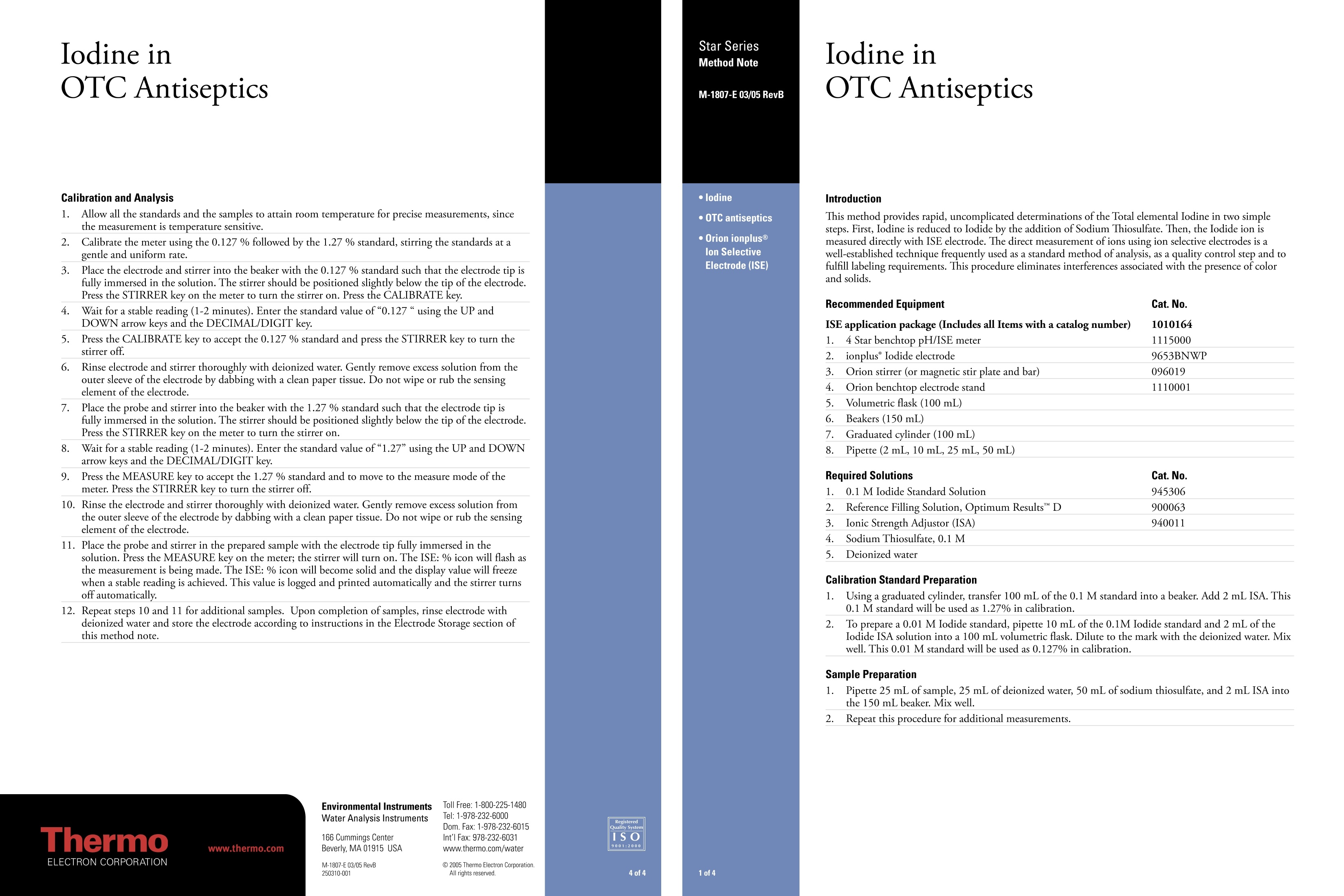
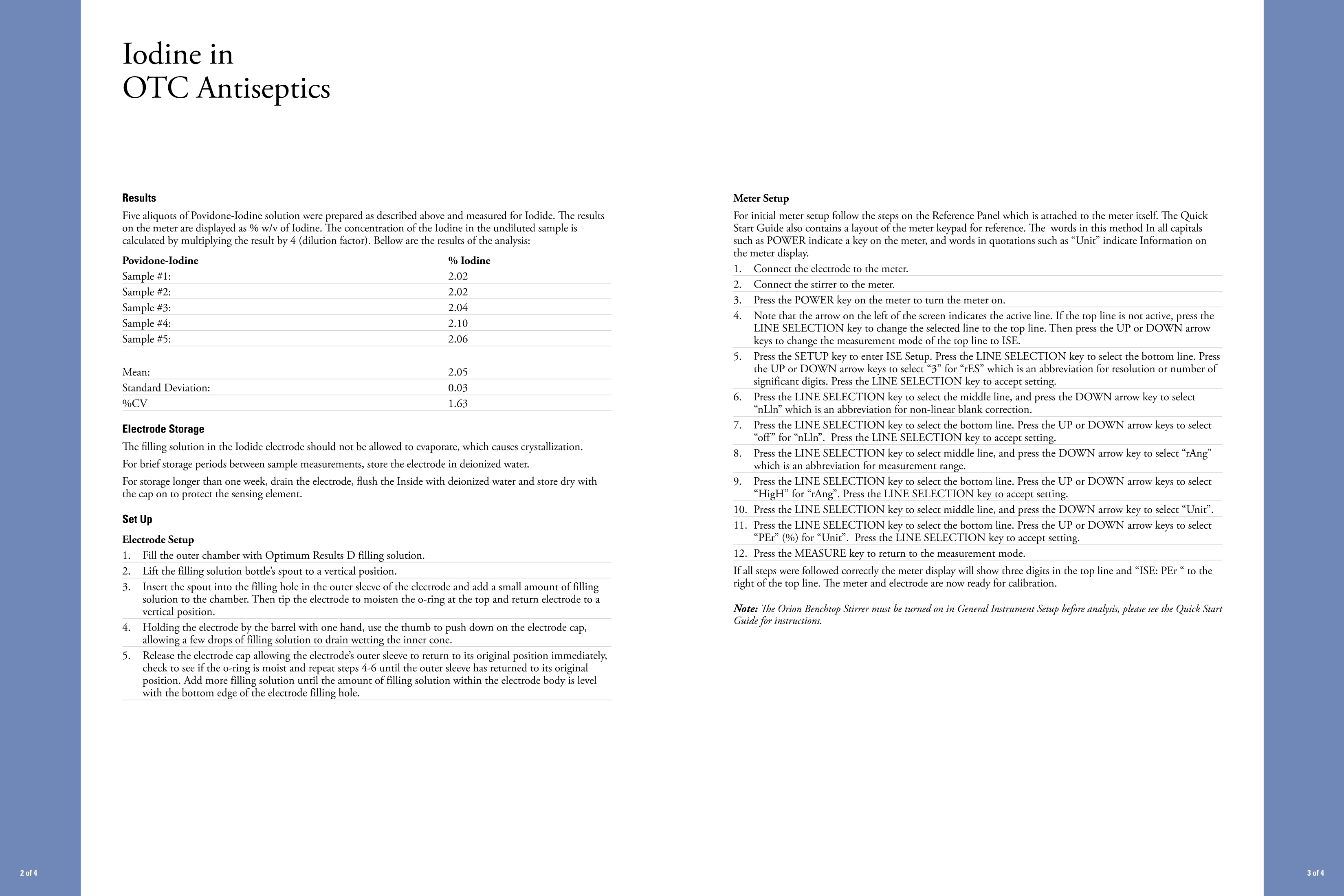
还剩1页未读,是否继续阅读?
赛默飞中国实验室产品事业部为您提供《防腐剂中碘的测定》,该方案主要用于其他中--检测,参考标准--,《防腐剂中碘的测定》用到的仪器有台式pH/ORP/ISE/溶解氧/电导率测量仪、Orion 4-Star台式(便携式)pH/离子浓度测量仪
推荐专场
相关方案
更多
